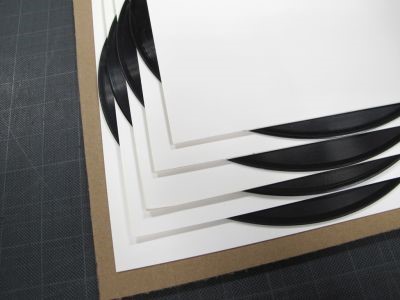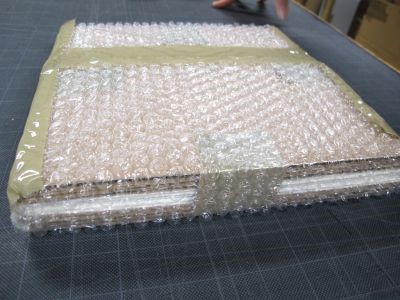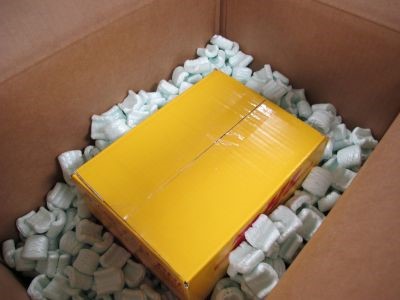GENERAL RECOMMENDATIONS
It is important to ensure safe transport of collection materials to their destination. Hand-delivery of materials is the safest option, but shipping may be necessary.
Even under the best of circumstances, shipping audio media involves some risk. Objects may be exposed to crushing, puncture, shock, vibration, and the elements, including drastic changes in temperature and relative humidity (RH). The possibility of damage during shipment can be minimized by packing objects securely and choosing an appropriate shipping service.
Descriptions of shippers and packing instructions for a variety of media follows. In addition, follow these general recommendations:
- Follow the packing instructions below. Pack objects securely to avoid shifting and damage during transit.
- Avoid over-packing large boxes that could fail to hold the weight of the media. Large, heavy boxes are more difficult to handle and are more likely to be dropped, whereas minimizing the size and weight of packages enhances the safety of the materials.
- Hand-deliver objects if possible. Use a commercial shipper to transport materials only when necessary.
- Packing materials need to be archival quality (pH-neutral) if they are in direct contact with the objects.
Specific materials for inner and outer wrapping and packaging are described below. - Ship on Monday, Tuesday, or Wednesday to decrease the risk of a weekend layover in a warehouse. If possible, do not ship over major holidays or during periods of extremely cold, humid, or stormy weather.
- Enclose a packing list of all objects as well as your name, mailing address, phone number, email address, and any special instructions. See the Inventory Form template at the end of this leaflet.
- Address shipments clearly and include your own return shipping address.
- Consult with an audio expert or conservator if you have questions, especially if the stability of the object(s) is an issue.
COMMERCIAL SHIPPERS
Fine Arts Shippers: These companies offer door-to-door trucking with special handling for valuable or irreplaceable objects, and most offer packing and crating services. Fine arts shippers are very reliable and usually relatively expensive. Companies can be found through an internet search or a recommendation from your local art museum.
UPS and FedEx: These carriers can provide a cost-effective solution when you cannot personally transport your objects to their destination or when a fine arts shipping provider is unnecessary. UPS and FedEx may set limits on the value allowed for certain types of materials, including artwork. Note that if you require actual insurance, it must come from a separate policy. Check the shipper’s website for limitations on package size and weight (typically 150 lbs and a combined 165 inches).
U.S. Postal Service Registered Mail: The U.S. Postal Service offers cost-effective shipping of artifacts of moderate size and value. Choose “Registered Mail” shipping — not merely Insured, Certified, or Priority Mail—because Registered Mail is the most secure USPS option. Check the USPS website for limitations on package size and weight.
SHIPPING tapes
Open-reel tapes should be packed in their original boxes, or in rigid containers such as corrugated board if they no longer have their cases. Archival quality, long-lasting containers are available from vendors such as University Products: https://www.universityproducts.com/audio-tape-storage-containers.html
For tapes in cassettes, original cases should be used. If a cassette does not have its original case, new ones are available for purchase from a variety of sellers (an internet search will suffice). Archival quality, long-lasting cassette cases are available from vendors such as University Products: https://www.universityproducts.com/catalogsearch/result/?q=audio%20cassette%20case
The tapes should be packed snuggly in their outer containers with some padding, such as bubble wrap, to avoid shifting and damage during transit. Limit the weight per box to what an average person can safely lift and carry.
SHIPPING grooved discs
Damaged/Broken Discs
Cracked, delaminating, or broken discs require special care. Consult an audio preservation specialist before shipping these materials. In some cases, shipping may be acceptable with the proper precautions. In other cases, you may wish to hire a specialist fine arts shipper, or ask if the destination you are shipping to provides a courier service for pickup within the region.
Intact Discs
Step 1: Sleeves or Interleaving
Discs can be stacked in groups of 5-10 of the same size. If your project includes dis
cs of various sizes, create a separate stack for each size. If the discs are not in sleeves, separate them with smooth paper to prevent scuffing by the outer boards or adjacent discs. (See photo below.) If you’re sending lacquer ‘acetate’ discs, use acid-free paper to prevent chemical damage to the disc.

Step 2: “The Sandwich”
Place rigid inflexible board on the top and bottom of the stack of discs, creating a ‘sandwich.’ For example, a 32” x 40” board will yield two 16” boards, six 12” boards, or twelve 10" boards.

You may use a single honeycomb board (below right) or two or three layers of corrugated cardboard (below left), alternating the ‘grain’ of the cardboard to improve rigidity.

Once the ‘sandwich’ is assembled, tape the boards together. You may place a small piece of paper in the middle of the tape to prevent the adhesive from transferring to the edges of the discs or sleeves.

Step 3: Cushion
Wrap the entire ‘sandwich’ in one or two layers of bubble wrap, and tape it shut.

Step 4: Double boxing
Place one or more bubble-wrapped sandwiches in a larger box full of styrofoam packing peanuts or other cushioning to further protect the discs from shock. It’s OK to pack several groups of discs together as long as there is sufficient space between the sandwiches and the outer box to protect against crushing, puncture, shock, or vibration. Be sure to limit the weight per box to what an average person can safely lift and carry; for example, three sandwiches of five discs each, or two sandwiches of ten discs each.

SHIPPING GROOVED CYLINDERS
Intact Cylinders
Unbroken wax cylinders should be packed in individual boxes. One type of individual box is a cylinder’s original box. A second type of individual box is a storage box available through University Products and designed under the guidance of NEDCC. This housing design (pictured below) allows the cylinder and its original container to be stored together in the same box, but in separate cavities. These boxes prevent contact with the grooves of the fragile cylinders and preserve the original container associated with the object, which is especially important when the container includes important metadata. If a cylinder does not have it’s original box, Hollinger Metal Edge offers a single-cavity storage container.

Cushion
Wrap each individual cylinder box in bubble-wrap and pack them together tightly into a box.

Double boxing
Place this box into a larger box filled with styrofoam packing peanuts, paper, or other clean cushioning. In addition to protecting the cylinders from physical shock, the extra layers thermally insulate the cylinders, slowing the rate of temperature change. Limit the weight per box to what an average person can safely lift and carry.

Broken Cylinders
Pieces of broken cylinder may take irregular shapes that are extra fragile. If a broken cylinder holds its shape in an existing container, it can be shipped as-is, with cotton or polyester padding stuffed in the middle of the cylinder to maintain outward pressure, preventing the pieces from falling in. Once the broken cylinders are secure in their containers, they can be cushioned and doubled boxed as described above.

If a broken cylinder cannot hold its shape, then the pieces should be packed separately so that they don’t abrade each other. Consult with an audio expert or conservator if you have questions.

ACKNOWLEDGEMENTS
This leaflet is based on Working with NEDCC: Packing and Shipping Audio Media, written by Jonathan Goodrich and Bryce Roe.
INVENTORY FORM TEMPLATE
_____________________________________________________________________________________________
Enclose this form in each box that you ship.
|
BOX _______ of _______ |
|
|
DESTINATION NAME: |
|
|
CONTACT NAME (if different): |
|
|
MAILING ADDRESS: |
|
|
|
|
|
|
|
|
STREET ADDRESS (if different): |
|
|
DESTINATION TELEPHONE: |
EMAIL: |
|
OWNER NAME: |
DATE: |
|
|
CONTACT NAME (if different): |
||
|
MAILING ADDRESS: |
||
|
|
||
|
|
||
|
STREET ADDRESS (if different): |
||
|
OWNER TELEPHONE: |
CONTACT TELEPHONE: |
|
|
EMAIL: |
||
OBJECT INVENTORY (Quantify and provide title and/or description or attach your own itemized list. Add rows as needed):
| Item title and/or description | Quantity |
SPECIAL INSTRUCTIONS (may include how to remove items from their packaging, to contact the owner upon receipt of the package, etc.):
